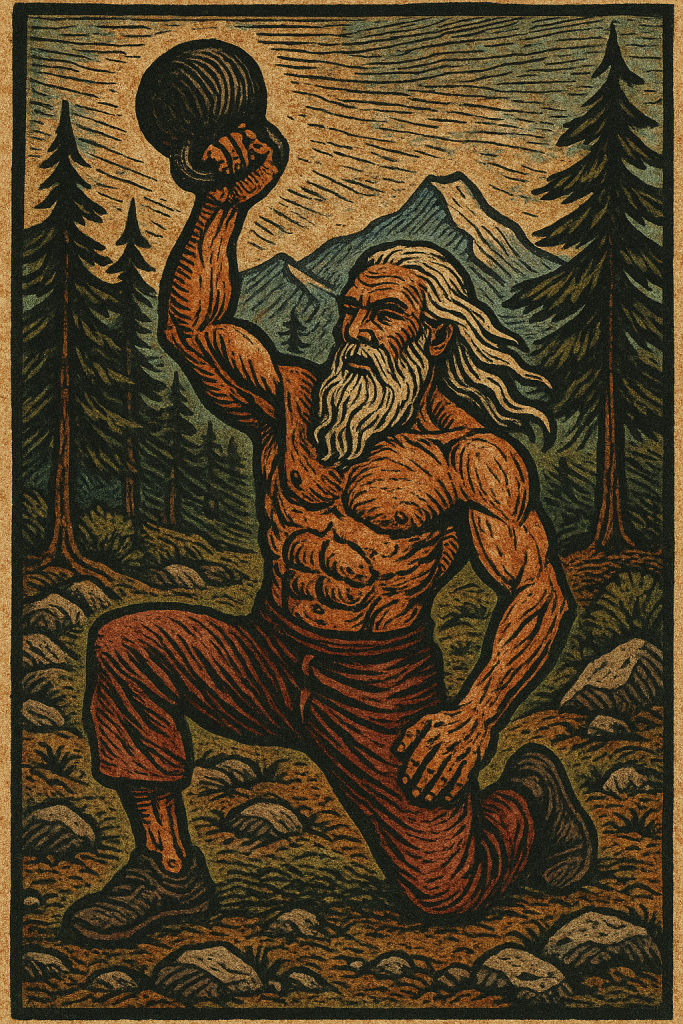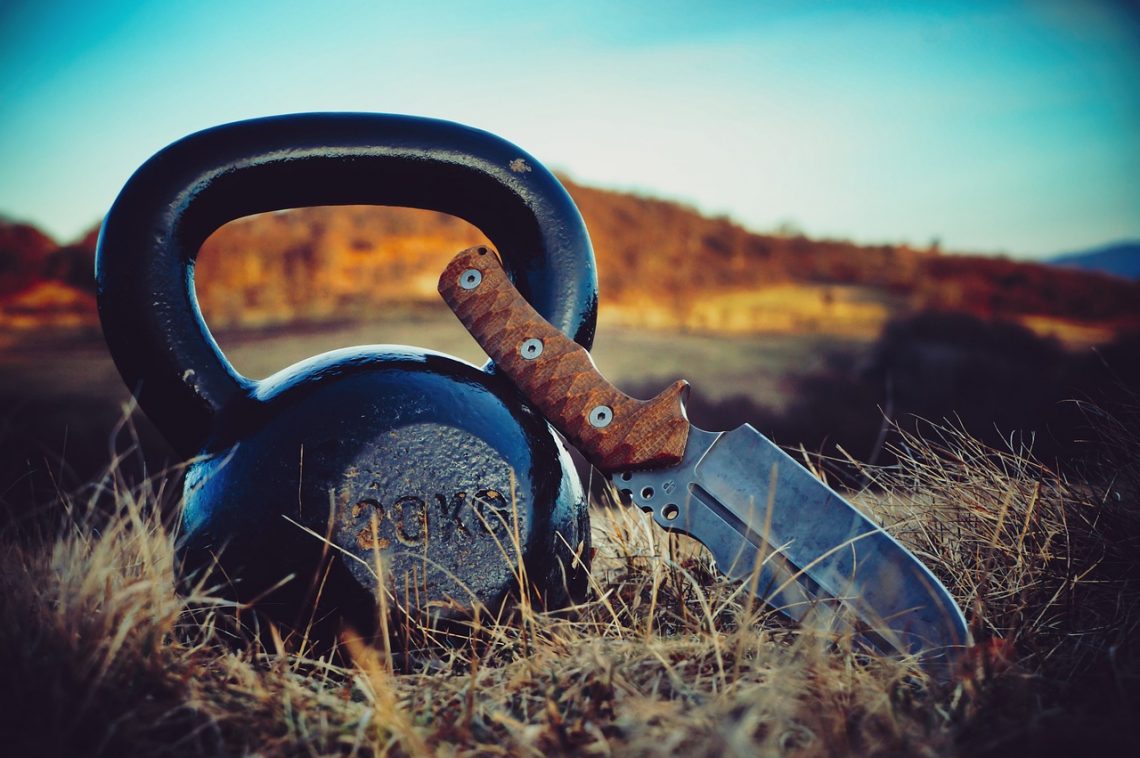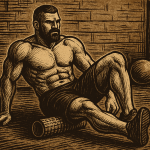Let’s get one thing straight: barbell training is a beast. If you want to stack on pure, brute force—deadlifts, squats, and presses under the iron are undefeated. No arguments here. But if you’re only chasing raw numbers and forgetting everything else – like mobility, joint health, explosive endurance, and practical real-world strength – you’re missing the forest for the trees.
This post isn’t a takedown of barbell training. It’s a manifesto for balance. A battle cry for those who want to be more than just a walking total. We’re talking about the hybrid edge—training with your own bodyweight and kettlebells to create a form of strength that’s raw, refined, and ridiculously effective.
So let’s break down why bodyweight + kettlebell training is the secret sauce you didn’t know you were missing – and why guys like Iron Wolf, Steve Maxwell, and Pavel Tsatsouline have been yelling about it for years while others chase 1RMs into the orthopedic ward.
1. Strength You Can Use (Anywhere, Anytime)
Here’s the brutal truth: the world doesn’t care how much you bench.
You ever try helping a friend move furniture, carry groceries up five flights of stairs, or sprint to catch a bus with a barbell on your back? Didn’t think so.
Bodyweight and kettlebell training cultivate what Steve Maxwell calls “travel strength”—a mix of control, balance, coordination, and stamina that translates directly to real life. You can drop and crank out push-ups, burpees, or kettlebell swings anytime, anywhere. No rack, no spotter, no excuses.
Mike Tyson didn’t build his legendary physique and fighting endurance under a squat rack. He did it through bodyweight punishment: 500 dips, 2000 sit-ups, 400 push-ups a day. This wasn’t just about aesthetics. It was about forging a body that could deliver destruction over 12 rounds. That’s not gym strength. That’s war strength.
2. The Engine That Doesn’t Quit: Conditioning Over Everything
You know what you don’t get from resting five minutes between heavy triples? Cardio.
Guys like Iron Wolf, the marine-turned-calisthenics-machine, know this. His YouTube channel is a temple of high-volume bodyweight workouts that hammer both muscle and lungs. 200 burpees? That’s just the warm-up. His routines are brutal but beautiful—designed to build what he calls “functional toughness.”
And over at the PowerTraining YouTube channel, you’ll find wrestling-inspired circuits that bring this hybrid edge into sharp focus. Wrestlers need max power, sure—but they also need to move with aggression for long stretches. That means circuits: push-ups, sprawls, squats, bear crawls, jumps. These aren’t workouts. They’re battles.
With kettlebells, it’s the same story. Try a 10-minute EMOM (every minute on the minute) of double kettlebell front squats and swings and tell me your lungs don’t feel like they’re being ripped open. This is conditioning with weight, not cardio for the sake of burning calories. We’re training to survive and thrive under load.
3. Joint-Friendly Longevity: Train Smarter, Not Just Harder
You can’t chase PRs forever. Ask your lower back.
Barbell lifts, when done with poor form or ego, can grind joints and inflame tendons over time. Don’t believe it? Visit any gym and count the knee sleeves and wrist wraps. That’s the barbell tax. Pay up or break down.
Bodyweight and kettlebell training offer another path. The movements are often closed-chain (your hands or feet stay planted), which puts less strain on your joints. Think push-ups vs bench press, goblet squats vs back squats.
Steve Maxwell, a pioneer of intelligent training, preaches this gospel: train for the long haul. His routines are full of mobility work, breath control, and controlled tension—where form and awareness matter more than the weight on the bar. His decades of injury-free movement are proof that kettlebells and bodyweight aren’t just scalable—they’re sustainable.
4. Explosive Athleticism: Power That Moves
Barbells build force. But what about speed? Precision? Agility?
Kettlebell training, with its ballistic movements like swings, snatches, and cleans—develops dynamic, full-body explosiveness. You’re not just grinding through reps; you’re launching weight with timing, rhythm, and grace. That’s coordination and power rolled into one.
The Bioneer, another standout voice in the hybrid scene, explores this often. His training blends calisthenics, kettlebells, and martial arts to develop true athleticism: jumping higher, punching faster, reacting quicker. He’s not chasing a big bench. He’s chasing high-performance human potential.
Add in bodyweight plyometrics—jump squats, clap push-ups, pistol squats—and you start tapping into the type of reactive strength that makes you fast, agile, and hard to hit. Perfect for fighters, parkour athletes, military, and anyone who wants their strength to mean something outside of the gym.

5. Mental Toughness: The Mind-Muscle Battle
Barbells are heavy, but they’re also forgiving. You do a set, you rest. You stare into the void between lifts.
Bodyweight and kettlebell circuits? There’s no void. Only volume.
Doing 100 push-ups, 200 swings, or 10 rounds of Iron Wolf’s brutal burpee ladder isn’t just physical—it’s psychological. You learn to suffer, to breathe under fire, to stay calm when your muscles are screaming. This mental edge isn’t just a side effect—it’s the core benefit.
Mike Tyson’s legendary bodyweight workouts weren’t just to build muscle. They built an indomitable mindset. Same with military circuits. Same with old-school wrestling rooms. When you train with high-rep, high-density bodyweight and kettlebell circuits, you’re training to become unbreakable. Period.
6. Space and Freedom: The Garage Warrior’s Paradise
Let’s be real: not everyone has access to a squat rack, bumper plates, or a spotter. Some of us train in garages, basements, parks, or hotel rooms.
That’s where the hybrid model shines. A couple kettlebells and a floor is all you need to build muscle, endurance, and skill. It’s minimalist, efficient, and free of fluff.
This is the Dapper Savage way – training that adapts to your life, not the other way around. You’re not chained to a gym membership or waiting in line for the bench press. You own your training, on your terms.
7. Mastery Over Numbers: Skill-Based Strength
Lifting a bar is raw. But lifting your body with precision is art.
Pull-ups, pistol squats, handstand push-ups, L-sits – these aren’t just exercises. They’re skills. They require neuromuscular mastery, body awareness, and relentless practice. Strength and coordination move together.
Pavel Tsatsouline, the kettlebell king, talks about this in his “Grease the Groove” approach. Instead of training to failure, you train frequently, with intent. It’s about quality reps, building neural patterns, and mastering the movement.
This skill-based philosophy is echoed across all hybrid systems. The goal isn’t just more—it’s better. More efficient reps, tighter technique, smoother control. You don’t just become stronger. You become more capable.
8. Recovery and Frequency: Train More, Hurt Less
You can’t deadlift heavy every day. Try it and you’ll be in a chiropractor’s office by the weekend.
But you can do push-ups, swings, and squats daily. That’s the magic of submaximal, full-body work – it’s recoverable. It builds work capacity without frying your CNS.
This is how Iron Wolf trains every day. It’s how fighters stay sharp between camps. It’s how Pavel recommends building resilience. Frequent, repeatable, intelligent training. No burnout. No breakdown.
9. Aesthetic Gains Without the Bulk Bloat
Want to look athletic without waddling like a meat brick?
Hybrid training shapes the body in a lean, muscular, functional way. Think of a gymnast’s upper body. A wrestler’s core. A fighter’s shoulders. This isn’t fluff muscle- it’s battle-tested tissue with utility.
Kettlebells sculpt the posterior chain. Calisthenics chisels the chest and arms. High-rep circuits shred fat without hours of cardio. You get strong, you stay lean, and you move like a panther.
10. Culture of the Hybrid Warrior
Let’s not ignore the energy behind all of this.
Barbell culture can sometimes fall into ego traps—chasing numbers, maxing out, flexing in the mirror. But the hybrid world? It’s a tribe of doers. Marines like Iron Wolf. Longevity masters like Steve Maxwell. Thinkers like The Bioneer. Warriors like Tyson. Tactical minds like Pavel.
It’s a culture built around movement, freedom, and discipline – not just clout.
And that’s what DapperSavage.com is all about: merging intellect with intensity, grit with grace, the raw with the refined. Hybrid training embodies that duality. It’s primal, but it’s polished. It’s old-school, but it’s future-proof.
The Wrap-Up: Who Should Train This Way?
If you’re chasing a powerlifting total, then sure—stick with the barbell. It’s the tool for that job.
But if you want to be:
- Strong and conditioned
- Mobile and explosive
- Resilient and skilled
- Independent and athletic
- Functional and aesthetic
…then bodyweight + kettlebells is your path.
The hybrid approach isn’t trendy. It’s timeless. It’s how warriors, fighters, athletes, and nomads have trained for centuries. It’s how you build a body that’s not just powerful, but capable – anywhere, anytime.
Don’t trade ability for numbers. Train to move, to endure, to dominate.
Strength isn’t just about what you can lift. It’s about what you can carry—in your body, your mind, and your life.
No excuses. No fluff. Just results.
Stay strong,
The Dapper Savage






Comments by The Dapper Savage